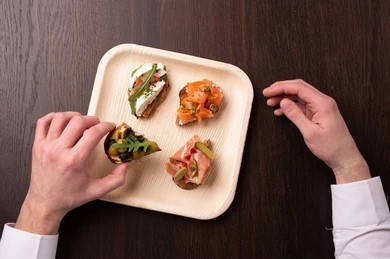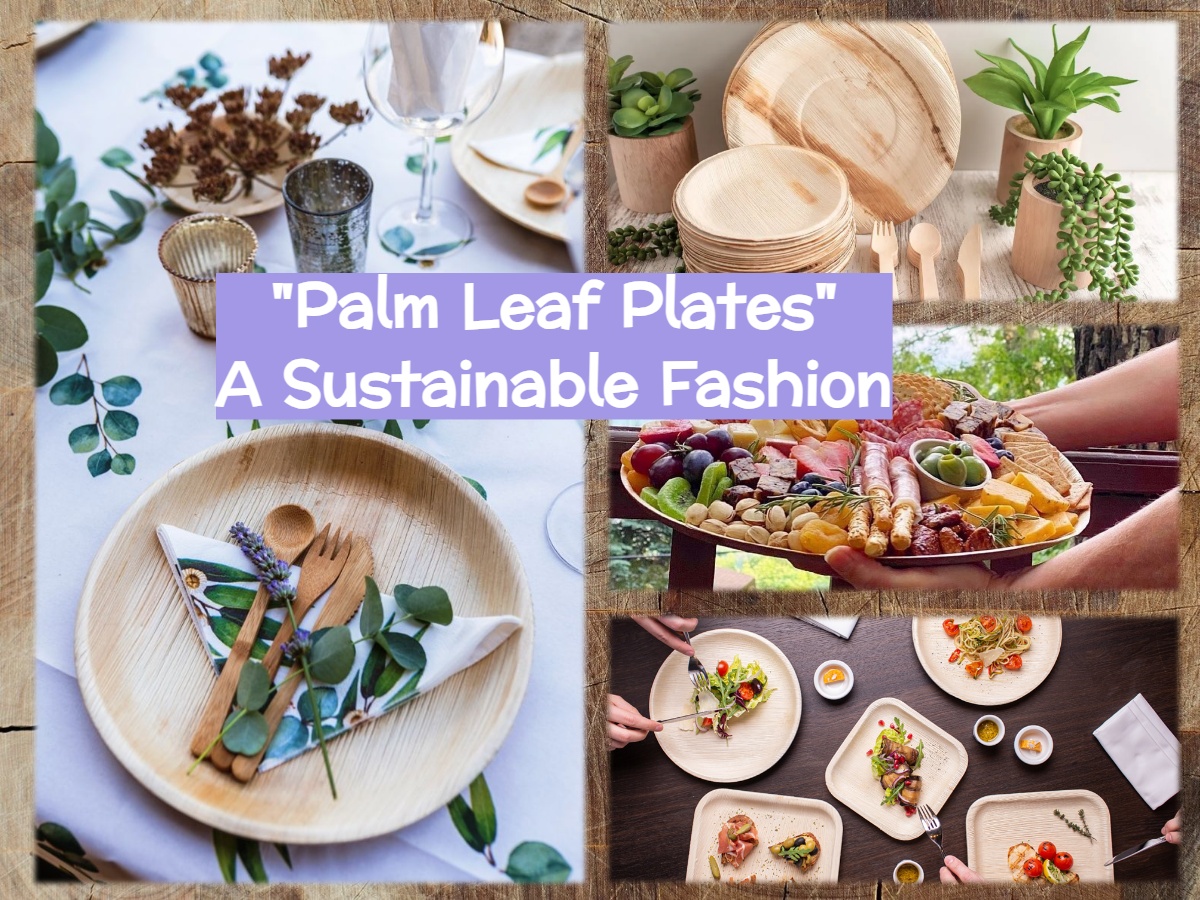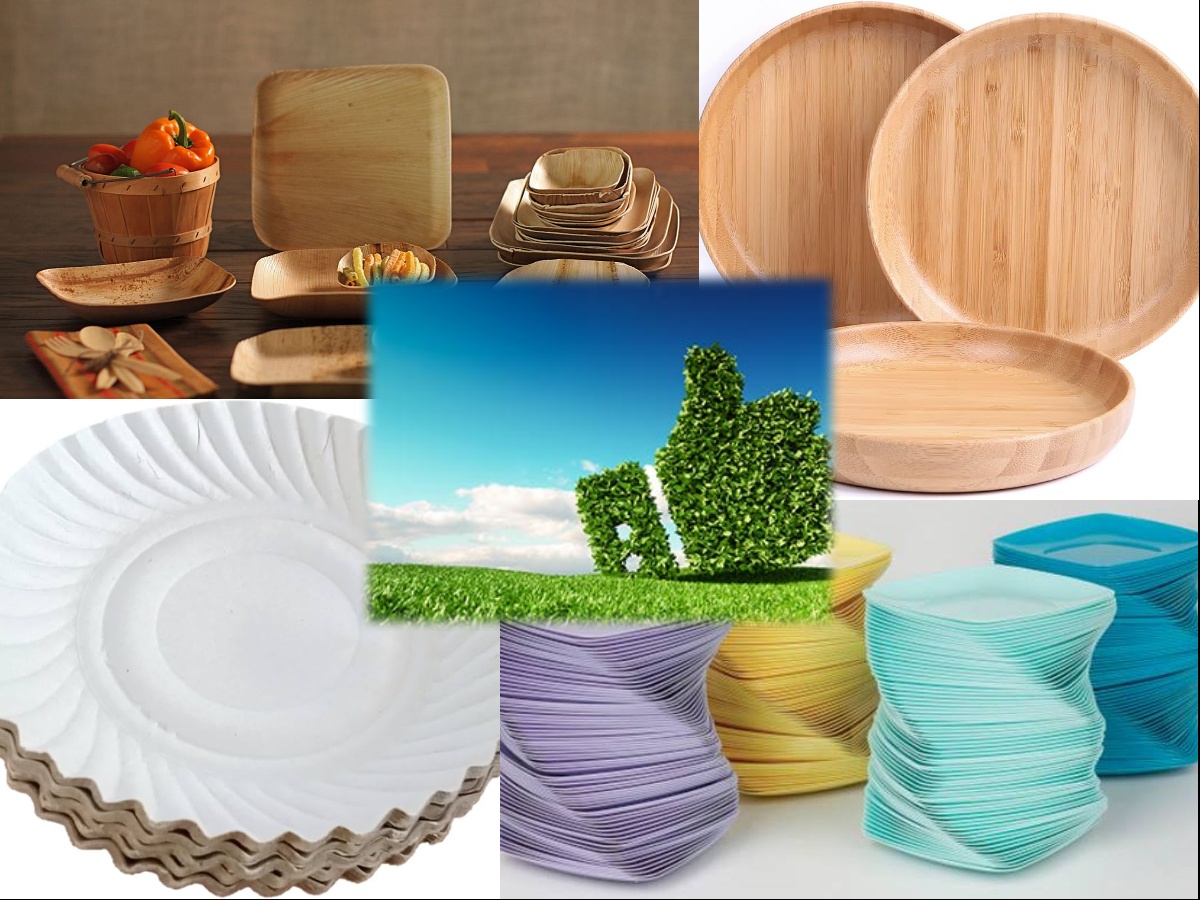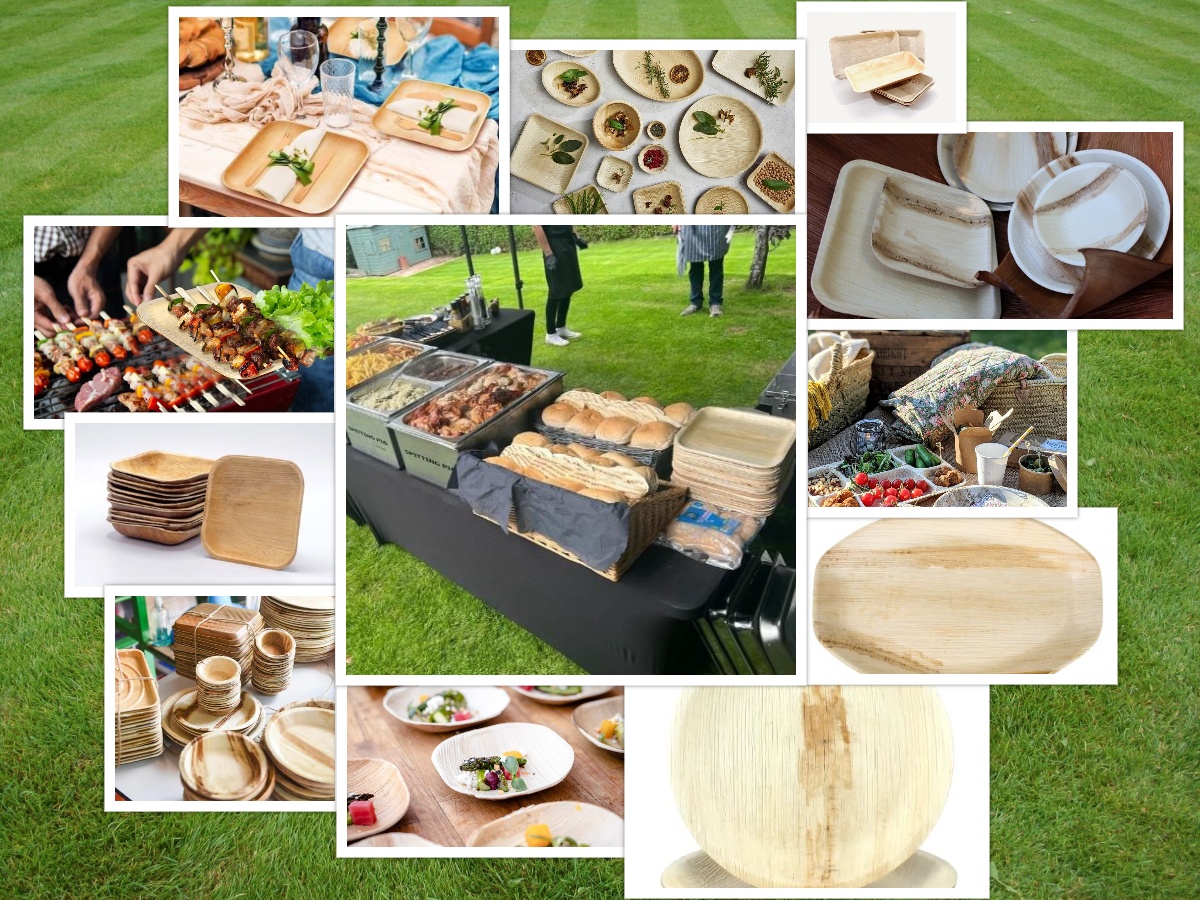In today’s environmentally conscious world, making sustainable choices has become more than just a trend—it’s a necessity. One such choice that’s gaining popularity, especially in the realm of event planning and home use, is palm leaf plates. These eco-friendly alternatives to traditional disposable plates offer numerous benefits, from environmental to aesthetic. Let’s dive into why palm leaf plates are the perfect choice for your needs.
Table of Contents
What Are Palm Leaf Plates?
Palm leaf plates are eco-friendly, disposable tableware made from the fallen leaves of the Areca palm tree. Unlike traditional disposable plates, which can be made from plastic or paper and contribute to environmental pollution, palm leaf plates offer a sustainable alternative. The process of making these plates is natural and straightforward, involving no harmful chemicals or synthetic materials.
The leaves used to make these plates are collected after they fall naturally from the trees, ensuring that no harm is done to the environment through deforestation or unnecessary harm to the plant. These fallen leaves are then cleaned, sometimes steamed for sterilization, and pressed into various shapes and sizes to create plates, bowls, and other types of serving dishes. This process uses heat and pressure but no chemicals, making the plates completely natural.
Palm leaf plates are known for their sturdy and durable nature, capable of handling heavy or wet food without bending or breaking, unlike many paper plates. They are suitable for hot, cold, wet, and oily foods, making them versatile for all types of meals and occasions, from formal events to casual picnics.

Manufacturing Process
- Collection of Leaves: The process begins with the collection of fallen leaves from the Areca palm tree. These leaves are gathered from the ground, ensuring that no trees are harmed or cut down for the production of the plates. This method not only prevents deforestation but also makes use of natural materials that would otherwise decompose and go to waste.
- Cleaning: Once collected, the leaves are thoroughly cleaned to remove any dirt and debris. This step is crucial for ensuring the hygiene and safety of the final product. The cleaning process usually involves rinsing the leaves with water, and sometimes, a mild, eco-friendly soap solution may be used to ensure thorough cleanliness.
- Sterilization: After cleaning, the leaves undergo a sterilization process. This can involve steaming or heating the leaves to a high temperature to kill any bacteria or pathogens, making the plates safe for food contact. This step is essential for meeting health and safety standards.
- Drying: Post sterilization, the leaves are dried to remove any moisture. This can be done naturally under the sun or in drying chambers, depending on the scale of production and the weather conditions. Proper drying is critical to prepare the leaves for the pressing process, ensuring they are malleable and free from mold or mildew.
- Pressing: The dried leaves are then placed into molds that shape them into plates, bowls, or other desired forms. This is achieved by applying heat and pressure, which molds the leaves without the need for any binding agents or chemicals. The heat also further sterilizes the leaves. The molds can create various shapes and sizes, allowing for a range of tableware products.
- Trimming and Finishing: After pressing, the edges of the plates and bowls are trimmed to create a smooth, finished look. This step ensures the products are uniform and aesthetically pleasing. Some manufacturers may also perform additional quality checks at this stage to ensure each product meets specific standards.
- Packaging: Finally, the finished palm leaf plates are packaged for sale. The packaging materials used are often eco-friendly, in line with the sustainable ethos of the product. The plates are then ready to be distributed to retailers or directly to consumers.

Environmental Benefits
- Sustainable Source: Palm leaf plates are made from the fallen leaves of the Areca palm tree, which means their production does not involve deforestation or harm to living trees. This sustainable sourcing ensures that the natural cycle of leaf shedding and regrowth is not interrupted, maintaining ecological balance.
- Biodegradable and Compostable: One of the most significant environmental benefits of palm leaf plates is their biodegradability. Unlike plastic, which can take hundreds of years to decompose and often ends up in landfills or oceans, palm leaf plates naturally break down into organic matter within a few months when composted. This means they can contribute to soil health, enhancing its nutrient content without leaving behind toxic residues.
- Reduction of Plastic Waste: By choosing palm leaf plates over plastic alternatives, consumers can significantly reduce the amount of plastic waste generated. Plastic pollution is a major environmental issue, contributing to habitat destruction, harming wildlife, and disrupting ecosystems. Palm leaf plates offer a practical solution to this problem by providing a compostable option that doesn’t contribute to plastic pollution.
- Energy and Resource Efficiency: The manufacturing process of palm leaf plates is energy-efficient and requires fewer resources compared to the production of plastic or paper tableware. Since the raw material is essentially a waste product (fallen leaves), the energy and resources needed to gather and process these leaves are minimal. This efficiency further reduces the environmental footprint of palm leaf plates.
- Chemical-Free Production: Unlike some disposable products that are produced using chemicals (for bleaching paper, for example) or contain additives (like plasticizers in plastic), palm leaf plates are free from chemicals. They are made using heat and pressure without the need for any synthetic additives, making them a safer and more environmentally friendly option.
- Contributes to Circular Economy: Palm leaf plates fit well into the concept of a circular economy, where products are used, recycled, or composted, and then returned to the earth as nutrients. This contrasts with the linear “take-make-dispose” model, which depletes resources and generates waste. By composting used palm leaf plates, consumers can close the loop, turning waste back into a resource.
- Low Carbon Footprint: The overall carbon footprint of palm leaf plates is lower than that of plastic or paper plates. This is due to the sustainable collection and processing methods, which require less energy and produce fewer greenhouse gas emissions. By choosing palm leaf plates, consumers can contribute to the global effort to reduce carbon emissions and combat climate change.

Reduction of Plastic Waste
- Eco-friendly Alternative: Palm leaf plates serve as a direct substitute for plastic plates. Every palm leaf plate used is one less plastic plate that could end up in a landfill or the ocean. Given the widespread use of disposable plates at events, parties, and in food service, switching to palm leaf plates can lead to a substantial reduction in plastic consumption and waste.
- Compostability: Unlike plastic, which can take hundreds to thousands of years to decompose, palm leaf plates are fully compostable. They break down into natural elements within a few months in a composting environment, leaving no microplastics or toxic residues behind. This compostability ensures that palm leaf plates do not contribute to the growing problem of plastic pollution and can instead enrich soil when properly composted.
- Consumer Awareness and Behavioral Change: The choice of palm leaf plates also fosters greater environmental awareness among consumers and businesses. As more people become conscious of the impacts of their choices on the planet, the shift away from plastic becomes part of a larger movement towards sustainability. This awareness can lead to further reductions in plastic use beyond just tableware, affecting purchasing decisions across a wide range of products.
- Support for Sustainable Practices: By choosing palm leaf plates, consumers support sustainable practices in manufacturing and waste management. This support can encourage more businesses to explore and invest in eco-friendly alternatives to plastic, expanding the market for sustainable products and further reducing reliance on plastic goods.
- Legislative and Policy Impact: Increased adoption of palm leaf plates and similar sustainable products can influence legislative and policy decisions. As public demand for eco-friendly alternatives grows, governments may be more inclined to enact regulations that limit plastic use and promote compostable and biodegradable options, leading to a broader reduction in plastic waste.
- Reduction in Manufacturing Demand for Plastic: Choosing alternatives to plastic, like palm leaf plates, decreases the overall demand for plastic. This reduction in demand can eventually lead to decreased production of plastic items, reducing the amount of raw materials extracted for plastic production and the energy used in manufacturing processes, further benefiting the environment.
Health and Safety Benefits
- Chemical-Free Production: Unlike some disposable plates that are made using synthetic chemicals or are processed with bleaches and dyes, palm leaf plates are produced without the use of any chemicals. The leaves are simply cleaned, heat-pressed, and shaped into plates. This chemical-free process ensures that there are no harmful substances that could leach into food, making palm leaf plates a safer option for serving meals.
- No Risk of Plastic Leachates: Traditional plastic tableware can sometimes leach chemicals like bisphenol-A (BPA) and phthalates into food, especially when used with hot foods or beverages. These chemicals have been linked to various health issues, including hormonal disruptions and increased risk of certain cancers. Palm leaf plates, being completely natural, pose no such risks, providing a safer alternative for serving and consuming food.
- Allergen-Free: Palm leaf plates are free from common allergens and are suitable for people with sensitivities to chemicals or certain materials found in other types of disposable tableware. This allergen-free characteristic makes them an excellent choice for events or establishments that cater to individuals with specific dietary restrictions or allergies.
- Sturdy and Leak-Proof: The natural strength and durability of the pressed palm leaves make these plates resistant to cuts, leaks, and punctures. Unlike paper plates that can become soggy and potentially break when holding wet or oily foods, palm leaf plates maintain their integrity. This reduces the risk of spills and accidents that can occur with less sturdy tableware, ensuring a safer dining experience.
- Suitable for Hot and Cold Foods: Palm leaf plates can safely hold hot and cold foods alike, without the risk of deformation or the release of harmful substances. This versatility ensures that they can be used for a wide range of dishes and serving temperatures, making them a practical and safe option for all meal types.
- Compostable and Hygienic Disposal: After use, palm leaf plates can be composted, which is a hygienic and environmentally friendly method of disposal. This reduces the risk of attracting pests and rodents that can be associated with the disposal of traditional food waste and disposable tableware, contributing to a cleaner and healthier environment.
- Reduces Exposure to Microplastics: With the growing concern over microplastics in the environment and their potential to enter the human body, using natural, compostable tableware like palm leaf plates helps reduce the overall production and disposal of plastic, thereby decreasing exposure to microplastics.

Aesthetic and Practical Benefits
- Natural and Elegant Appearance: Each palm leaf plate has a distinctive, natural look with unique textures and patterns that add an elegant and rustic charm to any table setting. Unlike uniform plastic or paper plates, the individual variations in palm leaf plates can complement a wide range of décor themes, from casual outdoor picnics to formal dining events. Their earthy tones and organic shapes are particularly appealing for events that prioritize natural aesthetics or eco-friendly values.
- Sturdy and Durable: Palm leaf plates are remarkably sturdy and resistant to bending, breaking, or sagging. This makes them capable of holding heavy or wet foods without the risk of leaks or spills, providing a reliable dining experience. Their durability is especially advantageous for catered events, outdoor gatherings, or any situation where traditional tableware might be impractical.
- Versatile Use: These plates are not limited to specific types of food or occasions. They can be used for serving a wide range of dishes, including hot, cold, wet, and oily foods, making them a versatile choice for all kinds of meals. Whether it’s a barbecue, a wedding reception, a corporate event, or everyday home use, palm leaf plates can adapt to the needs of the occasion.
- Microwave and Oven Safe: Unlike some disposable options, palm leaf plates can safely be used in microwaves and conventional ovens for warming food, offering convenience and flexibility in food preparation and serving. This practical benefit is particularly useful for event planning, catering services, and busy households.
- No Two Plates Are Exactly Alike: The individuality of each plate adds a personal touch to servings, making meals feel more special and curated. This uniqueness can enhance the dining experience, making it memorable for guests and customers.
- Ease of Cleanup and Disposal: After use, palm leaf plates can be composted or disposed of without guilt, as they are biodegradable. This easy cleanup and disposal process is highly beneficial for large events where washing dishes is impractical, and environmental consciousness is a priority.
- Complements Eco-friendly Themes: For events or brands that emphasize sustainability, palm leaf plates visually reinforce this commitment. Their use can be a talking point and demonstrate to guests or customers a dedication to reducing environmental impact.
- Safe for All Guests: Being chemical-free and made from a natural source, palm leaf plates are safe for guests of all ages, including children. Their non-toxic nature ensures that everyone can enjoy their meal without concerns about harmful substances.
Conclusion
Choosing palm leaf plates is a small but significant step toward a more sustainable and eco-friendly lifestyle. With their myriad of benefits, from environmental to practical, they offer a viable alternative to traditional disposables. Make the switch today and contribute to a healthier planet for future generations.
FAQs
Are palm leaf plates reusable? No, they are designed for single use but are biodegradable and compostable.
How do palm leaf plates compare to paper plates? Palm leaf plates are sturdier, more environmentally friendly, and have a unique aesthetic compared to paper plates.
Can palm leaf plates be used for all types of food? Yes, they can handle hot, wet, and oily foods without issue.
How should palm leaf plates be disposed of? They can be composted or placed in the biodegradable waste bin.
Where can I purchase palm leaf plates? They are available at many online retailers, eco-friendly stores, and some supermarkets.










